ISSN ONLINE(2319-8753)PRINT(2347-6710)
ISSN ONLINE(2319-8753)PRINT(2347-6710)
Asish Maity1, Soumen Teli2
|
| Related article at Pubmed, Scholar Google |
Visit for more related articles at International Journal of Innovative Research in Science, Engineering and Technology
Bibliometric is a technique or a tool of information management, which is also called quantitative science. In the field of Library and Information Science, Bibliometric as it is presently known is of recent origin, though its roots could be traced to a study made 85 years ago in 1917. Since then it has come a long way and attain much importance and significance for Library and Information Managers. Bibliometric has practices applications in the evaluation of Library operation and survey through statistical techniques to make the quantitative analysis possible. It is also useful in the study and measurement of publication pattern of different form of literature on one subject or other and also useful in the study of productivity of authorships pattern of articles. The techniques Bibliometric have extensive applications equally in sociological studies of science, information management, librarianship, history of science policy. Study of science and scientists, etc.The Present study on DOAJ data base shows that how many articles published in a particular area of Library and Information Science subject and also shows that how many single author, double authors, triple authors, and more than three authors contribution in the subject area of Library and Information Science. The present study will helps to indentify the research scenario and the lacking areas of research.
Keywords |
| Bibliometric Analysis, DOAJ, Library and Information Science |
INTRODUCTION |
| Bibliometrics is a statistical analysis of books, articles and other publications.Bibliometric analysis use data on numbers and authors of scientific publications and on articles and the citations therein (and in patents) to measure the “output” of individuals/research teams, institutions, and countries, to identify national and international networks, and to map the development of new (multi-disciplinary) fields of science and technologyDirectory of Open Access Journals is a service that provides access to quality controlled Open Access Journals. The aims of DOAJ is to cover all open access scientific and scholarly journals that use an appropriate quality control system, and it will not be limited to particular languages or subject areas. The aim of the Directory is to increase the visibility and ease of use of open access scientific and scholarly journals thereby promoting their increased usage and impact originally. |
II. LITERATURE REVIEW |
| ïÃÆÃË Rattray (2013) made a study whoseaim was to complete an audit on the number of open access journals within the discipline ofExercise Science. Publishing in open access journals results in wide dissemination of material in a very short period oftime compared with the more traditional way of publishing in a subscription journal. The 2010 ERA journal list, category Human Movement and Sport Science, was initially utilized and then compared with the openness of the same journals in2012.In these study journals were audited for their degree of open access, open licensing and open format. Open access relates tithe free online availability of research results and hence research publications and in the discipline of exercise sciencerelates to the concept of an idealized level playing field. Open licensing relates to the ability of the consumers to replicate and share those publications freely whilst open format relates to the use of open and transferrable format types. Openaccess increased (p=0.014) as did our measurement of open licensing (p=0.000) and open formats (p=0.021) between the2010 and 2012 reviews of the journals in 1106 For code.This study reveals an increase in the number of Exercise Science journals that have full or partial open access over the twoyear period and suggests that authors are increasingly adopting peer reviewed open access journal publications. It is evident from this study that the impact of open access journals be assessed and further research into the feasibility of such a rating is imperative. |
| ïÃÆÃË Stenson (2012) argued for the value of the directories, mainly focusing on two of them: DOAJ and DOAB. It provides an introduction to the services, containing a brief history and status report, and addresses the differences between OA journal publishing and OA monograph publishing. It also highlights the value of these services and discusses whether the financial models behind them are sustainable |
| ïÃÆÃË Koohang (2006) demonstrated that advanced technologies and the increasing acceptance of academicopen access e-journals offer an opportunity to reconsider their form and function as a medium to enhance scholarly communication. The academic open access e-journal is envisioned as a platform and a portal within the context of an open source community including a format and functions that enable it to achieve that objective. A working model for academic open access ejournals is presented. This model is intended for open source communities involved in designing, developing, and/or improving open access academic e-journals. |
| ïÃÆÃË Kumar (2013)stated that there are many online databases available on internet that provides open access journals of various disciplines. The facility to access of these journals that is freely available on internet should be launch in the libraries. The present study deals with open access journals accessible from Directory of Open Access Journals (DOAJ) in the subject of library science. Analyzed based on country, keywords, frequency, etc. The analysis indicates that there was only one open access journal i.e. Bulletin of the Medical Library Association was available before 1990 in the field of library and information science (LIS). Only 19.04% journals have their EISSN. Almost one fourth journals were publishing on half yearly basis. |
| ïÃÆÃË Walter (2011)examined the characteristics of 663 Open Access (OA) journals in biology, computer science, economics, history, medicine, and psychology, then compare the OA journals with impact factors to comparable subscription journals. There is great variation in the size of OA journals; the largest publishes more than 2,700 articles per year, but half publish 25 or fewer. While just 29 percent of OA journals charge publication fees, those journals represent 50 percent of the articles in our study. OA journals in the fields of biology and medicine are larger than the others, more likely to charge fees, and more likely to have a high citation impact. Overall, the OA journal landscape is greatly influenced by a few key publishers and journals. |
| ïÃÆÃË Hulagabali (2012)analysed the Library and Information Science (LIS) journals with the aid of bibliometric methods. The study covers year-wise, country-wise and language-wise. Distribution of LIS journals archived in Directory of Open Access Journals (DOAJ). The year-wise growth of LIS journals, in DOAJ, started in the year 2003 with 21 journals. Till 2009, it has archived 97 LIS journals in its database. The LIS domain stands third position, under the social science stream, out of 960 journals listed under ten major disciplines in DOAJ database. In a country-wise distribution of LIS journals, developed countries top the share. In view of languagewise distribution of LIS journals, 71 journals are monolingual and only 15 journals are bilingual. Out 97 journals 40 journals are being published in English language. The very bibliometric study helps understand thepublication and archival trends of open access developments in LIS domain. |
III. OBJECTIVES |
| The major objectives of this bibliometric study are as follows: |
| ïÃâ÷ To observe what extent of research articles had been published in the subject area of Library and information Science. |
| ïÃâ÷ To identify the authorship pattern in the articles of LIS journals. |
| ïÃâ÷ To locate a new research area for researchers. |
| ïÃâ÷ To indentify the languages in which research is being conducted. |
IV. SCOPE |
| The Present study is limited within the database of Directory of Open Access Journals and the subject area is Library and Information Science. The articles which were published in English languagepublished from the year 2004 to 2014 were only taken into consideration. Analysis has been done to know the authorship pattern and subject area of LIS which has maximum productivity and also find out year-wise productivity of articles. |
V. METHODOLOGY |
| All the selected journal of Library and Information Science has been searched from Directory of Open Access Journals (DOAJ) data base only those journals which published in english language have been selected. After that all the issue of all volume has been collected from the journals published from the year 2004 to 2014. Collected articles have been arranged in chronological order after that it has been counted to know the authorship pattern of the article.Then a graphical representation have been made so that, a concept may be emerged about recent trend. |
VI. FINDINGS |
| Name of the Selected LIS journals on Directory of Open Access Journals (DOAJ) |
| ïÃÆÃË Bulletin of the American society for Information science and technology |
| ïÃÆÃË Cybermetrics international journal of scientometrics |
| ïÃÆÃË D lib magazine |
| ïÃÆÃË DESIDOC journal of library |
| ïÃÆÃË Informing science the international journal of an emerging trans discipline |
| ïÃÆÃË Issues in science and technology librarianship |
| ïÃÆÃË Journal of digital information |
| ïÃÆÃË Journal of electronic publishing |
| ïÃÆÃË Journal of southern academic and special librarianship |
| ïÃÆÃË Library and information research into practice for information |
| ïÃÆÃË Libres library and information science research electronic journal |
| ïÃÆÃË Singapore journal of library & information management |
| ïÃÆÃË Webology |
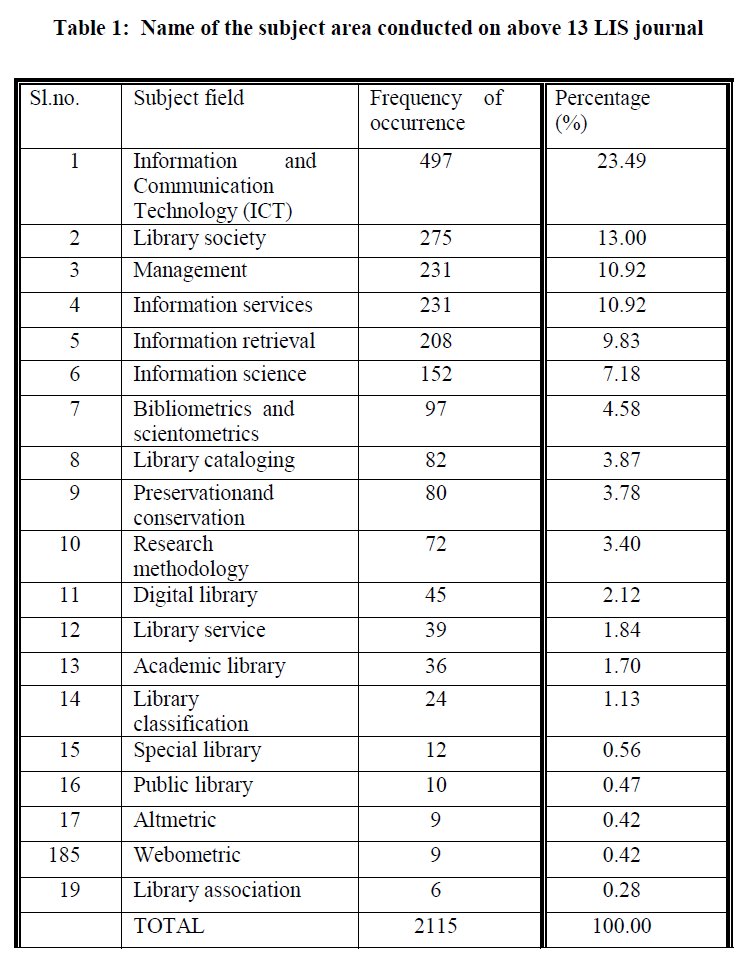 |
Articles productivity in a prticular area of LIS |
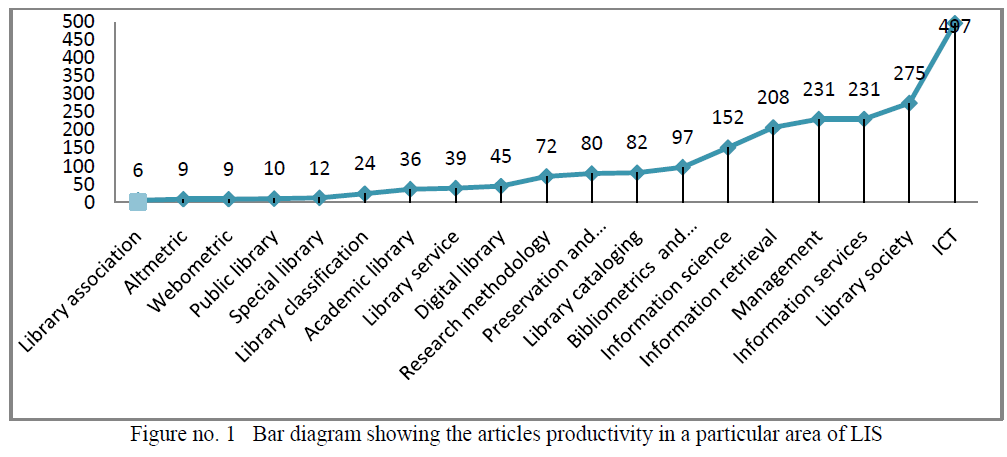 |
VII. INTERPRETATION |
| After analysis of research articles productivity on subject subfields of LIS it was found that the field of Information and Communication Technology is more prominent in case of research article productivity. That was followed by Library society, Information services, Information retrieval. But some sub fields have very less productivity like Library association (6), Altmetric (9), Webometric(9), Public library (10), Special Library (12), Library classification (24) |
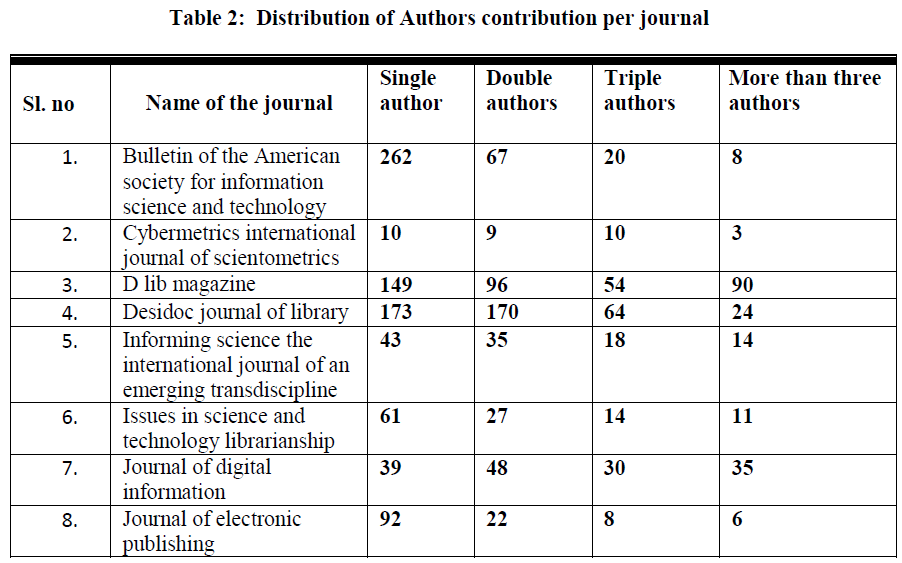 |
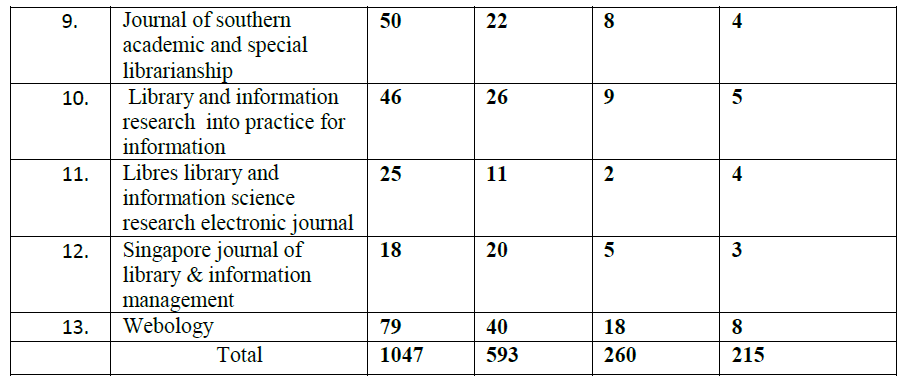 |
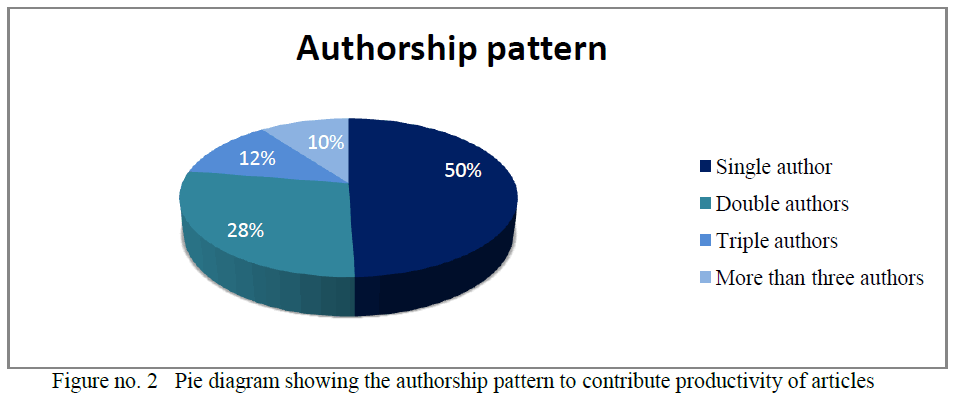 |
VIII. INTERPRETATION |
| Here we see that major productivity has been by single author. Then double author is in second place. Triple author is just after of double author and finally more than three authors are in fourth place. |
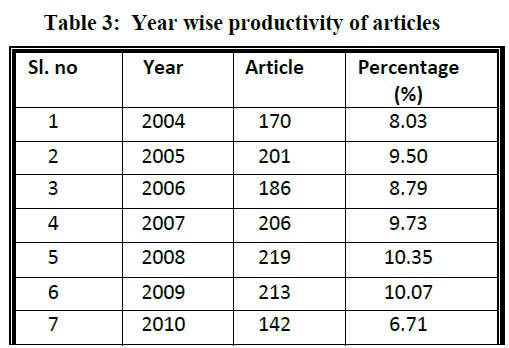 |
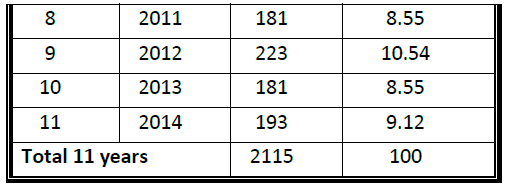 |
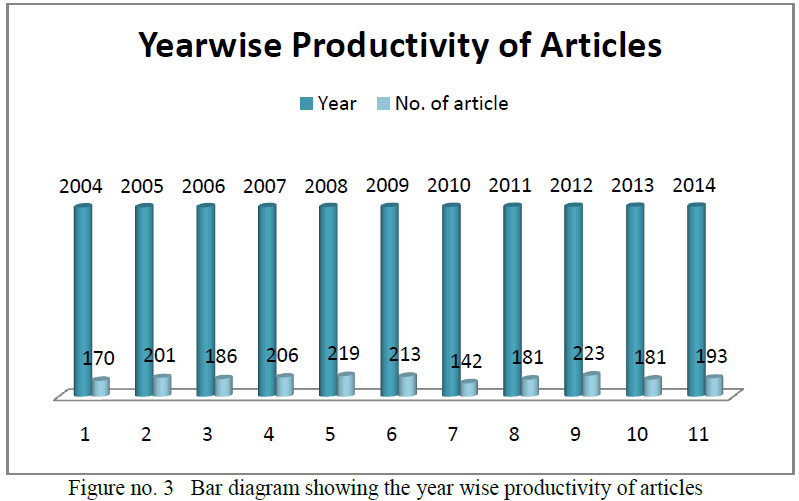 |
IX. INTERPRETATION |
| After analysis of year wise research articles productivity on LIS subject field it shows that in the year 2013 productivity of research articles is very high in respect of these 10 years. |
X. CONCLUSION |
| After studying DOAJ database it was found that maximum productivity in the field of Library and Information Science is in the Information and Communication Technology subfield, followed by Library and society, Library association and then by Management. The least productivity has been noticed in the subfield of Library association, Altmetric, Webometric, Public library, Special Library, Library classification. Authorship pattern showed that contribution of single author’s productivity on research articles is very high in numbers and more than three author’s contribution to publish research articles is very low.So, we must try to concentrate on the fields where the research articles productivity is very low. Otherwise this subfield will be wiped out. |